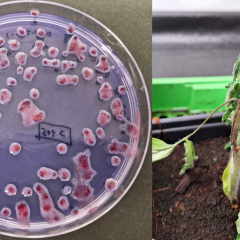Research project Exploring practical applications of metabarcoding with MinION to support the surveillance of plant pathogens
General introduction
A MinION metabarcoding device is suitable and in certain cases an added value for the detection and identification of plant pathogens. That is the conclusion from several case studies ILVO conducted in the METAMINSURV research project. It worked well for an initial screening for the presence of fungal pathogens. Mixed infections of phloem bacteria also succeeded better via MinION metabarcoding than classical Sanger sequencing. MinION metabarcoding runs on the basis of so-called nanopore sequencing. The advantage is that DNA base sequences can be determined via a portable DNA sequencing device (MinION). The METAMINSURV project investigated its use and feasibility for fast and accurate detection and identification of plant pathogens in a diagnostic context .
Research approach
Two cases were developed: 1) bacteria located in the phloem of a plant, specifically "Candidatus Phytoplasma" and "Candidatus Liberibacter" species and 2) pathogenic fungi in forests in complex communities of different origins (seeds of conifers and spore traps). To identify the potential of MinION metabarcoding, several technical challenges surrounding the metabarcoding process were clarified and addressed during the project. Applied to both case studies, ILVO answered the following specific research questions: Which barcode(s), primer(s) and reference database(s) combinations are suitable for the case studies in question? What are the advantages and limitations of using MinION metabarcoding for the detection and identification of plant pathogens (i.e., what is the sensitivity, specificity, speed, cost)? Finally, how useful are the developed protocols for other barcode/organism combinations?
Relevance/Valorization
For fungal pathogens, it was concluded that the MinION metabarcoding technique can be used for both initial screening for fungal presence and for monitoring studies, provided good controls are used. Although MinION metabarcoding was better at detecting mixed infections than classical Sanger sequencing in the second case study on phloem bacteria, the advantage did not outweigh the higher cost of the technique. However, based on the project results, an improved identification scheme for these bacteria could be established. Finally, general guidelines, protocols and bioinformatics analysis methods were also established so that the methods developed within this project could also be used for new case studies.
Financing
FOD Volksgezondheid, Veiligheid van de voedselketen en Leefmilieu






